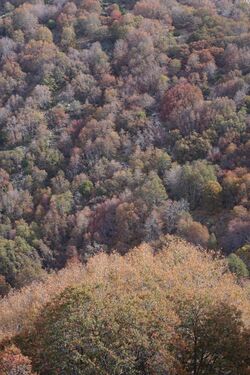Biology:Nothofagus macrocarpa
| Nothofagus macrocarpa | |
|---|---|

| |
| Nothofagus macrocarpa forest on Cerro El Roble | |
| Scientific classification | |
| Kingdom: | Plantae |
| Clade: | Tracheophytes |
| Clade: | Angiosperms |
| Clade: | Eudicots |
| Clade: | Rosids |
| Order: | Fagales |
| Family: | Nothofagaceae |
| Genus: | Nothofagus |
| Species: | N. macrocarpa
|
| Binomial name | |
| Nothofagus macrocarpa (A.DC.) F.M.Vázquez & R.A.Rodr. (1999)[2]
| |
| Synonyms[2] | |
| |
Nothofagus macrocarpa, commonly known as roble de Santiago or Santiago's oak, is a deciduous tree in the Nothofagaceae family that is endemic to the mountains of central Chile.[1]
Description
Nothofagus macrocarpa is a tree growing 4 to 10 meters tall. It has a stout trunk, either single or with two or three growing from the base. The bark is rough and grayish brown with longitudinal and transverse cracks. It has a leafy and densely-branched crown 3 to 5 meters wide. Leaves are bright green and wavy at the edges, typically oval, and measure 13 to 45 mm long by 7 to 23 mm wide.[3]
Range and habitat
Nothofagus macrocarpa grows at higher elevations of the Altos de Cantillana, in Melipilla Province southwest of Santiago, at approximately 2,200 meters elevation.[3] It is also found to the east in the Andes foothills of Cachapoal Province from 500 to 2,000 meters elevation.[1]
Populations on Cerro El Roble and other nearby mountains once identified as N. macrocarpa were reclassified in 2000 as a distinct species, Nothofagus rutila.[3]
Classification
It is sometimes regarded as a subspecies of Nothofagus obliqua.[4] In 2013 Heenan and Smissen proposed renaming N. macrocarpa to Lophozonia macrocarpa.[5]
References
- ↑ 1.0 1.1 1.2 Baldwin, H. (2018). "Nothofagus macrocarpa". IUCN Red List of Threatened Species 2018: e.T96478456A96480000. doi:10.2305/IUCN.UK.2018-2.RLTS.T96478456A96480000.en. https://www.iucnredlist.org/species/96478456/96480000. Retrieved 20 November 2021.
- ↑ 2.0 2.1 Nothofagus macrocarpa (A.DC.) F.M.Vázquez & R.A.Rodr. Plants of the World Online. Retrieved 21 April 2023.
- ↑ 3.0 3.1 3.2 Ravenna, Pierfelice (2002). Nothofagus macrocarpa y Nothofagus rutila (Fagaceae), dos especies diferentes. Onira 2002, 7: 57–60.
- ↑ "Nothofagus macrocarpa". http://www.florachilena.cl/especies.php?id=2843.
- ↑ HEENAN, PETER B.; SMISSEN, ROB D. (2013). "Revised circumscription of Nothofagus and recognition of the segregate genera Fuscospora, Lophozonia, and Trisyngyne (Nothofagaceae)". Phytotaxa 146 (1): 131. doi:10.11646/phytotaxa.146.1.1. http://biotaxa.org/Phytotaxa/article/view/phytotaxa.146.1.1/5539. Retrieved 31 May 2015.
Wikidata ☰ Q6045626 entry
 |


